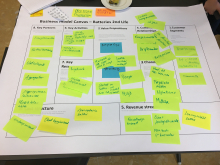
Creating impact is all about “scale” – isolated solutions and best practices will not manage to achieve the environmental, economic and social benefits we need to make. That’s why IRIS Smart Cities has not only identified innovative solutions to urban challenges; but works to achieve a citywide scale-up supported by sustainable demand and market dynamics.
To transform the local market and support this process, IRIS Smart Cities introduces the ‘Business Model Adaptation Tool’. It helps cities, solution providers and solution managers across the project to understand their individual roles in scaling up demonstrated solutions and helps move from one smart district to an entire smart city – faster.
The tool is designed to adapt business models for IRIS solutions according to their specific context, helping create local champions ready for citywide adoption.
It is designed to help wide scale adoption by helping:
- City partners understand their individual role in the scaling up process
- Produce roadmaps for scaling up demonstrated IRIS solutions
- Identify necessary support from city authorities to stimulate the market.
“The business model adaptation tool is easy to understand and apply as it is designed as a workshop. It’s based on three steps; the business model canvas, Porter’s five forces and impact mapping” says Jonas Norrman, expert on business innovation at IMCG.
The Business Model Adaptation Tool is easy to understand and use, based on three different steps:
- The business model canvas methodology – to describe relationships across the value chain
- A discussion on Porter’s Five Forces – to describe competing alternatives on the market
- Impact Mapping – to describe the city scale-up process
The tool will be used at workshops on an integrated IRIS solution in each Light House City during early autumn 2019 through to early spring 2020.
Case study: business model adaptation workshop on 2nd life batteries
During spring of 2019, a first training event on how to use the tool was arranged. The case was an IRIS demonstration site using 2nd life bus batteries in Gothenburg (Sweden). Here lithium-ion batteries from a local bus line (ElectriCity) were installed in the apartment building Viva (Riksbyggen) to store self-produced solar electricity.
New-built residential properties face significant increases in electricity demand, partly as a result of electrical vehicle charging, intended to reduce the climate impact of our mobility choices. But it is also costly to expand a power grid to deliver higher loads. Therefore, new solutions are needed for the electricity supply of properties and charging posts. The value proposition to the end-users is positive energy buildings and peak-power shavings.

The business model adaptation workshop in March 2019 was constructive and provided new important insights to the 16 participants representing numerous stakeholders. After the workshop, the result was a described value chain with four actors directly contributing to delivering end-user value and the functionality for the property owner.
“There was as an increased understanding of the end-customer’s alternatives to the solution along the value chain. It was also clear that if the end-customer does not choose this solution, no one in the value chain gets any revenue. The workshop also showed that several of the partners intended business model overlap that need to be further developed and adapted to the local value chain” says Jonas Norrman at IMCG.
Recommendation on up scaling
Two processes will support citywide scale-up. If the property owner demonstrating the solution has a larger property portfolio in the city, they can contribute to local up scaling of the solution. If the property owner does not own more buildings, the city should disseminate knowledge from the demonstration project to other relevant property developers.
For more information about results, or to requesting a training event, contact IRIS project partner IMCG
Ulrika Wahlström
Innovation Project Manager
ulrika.wahlstrom@imcg.se
29 May 2019

